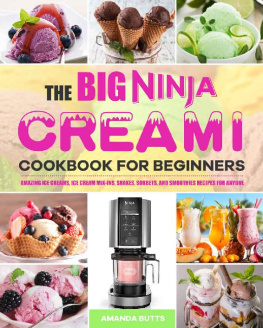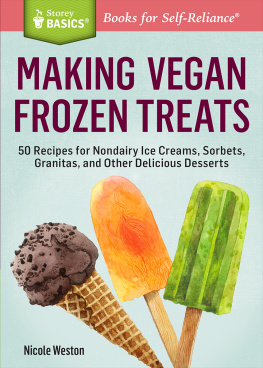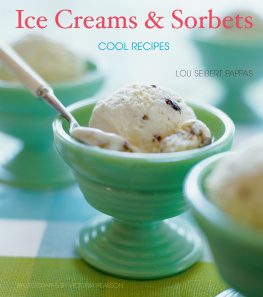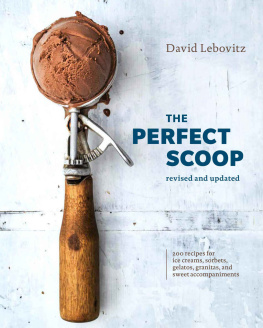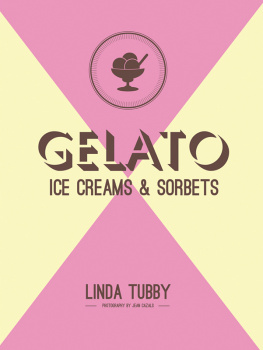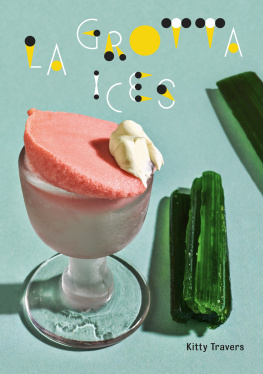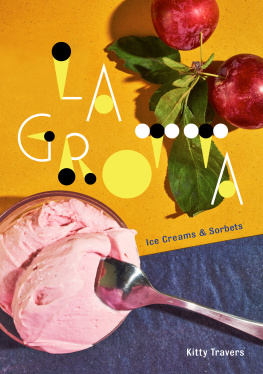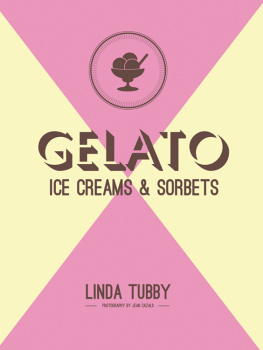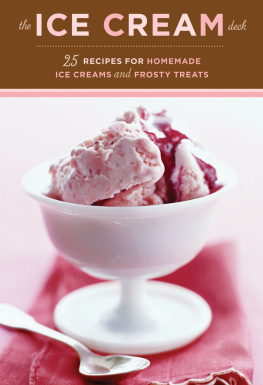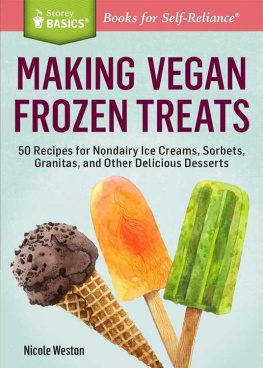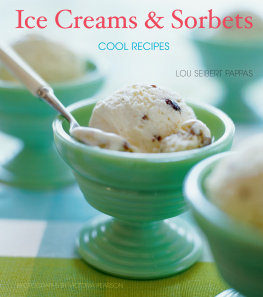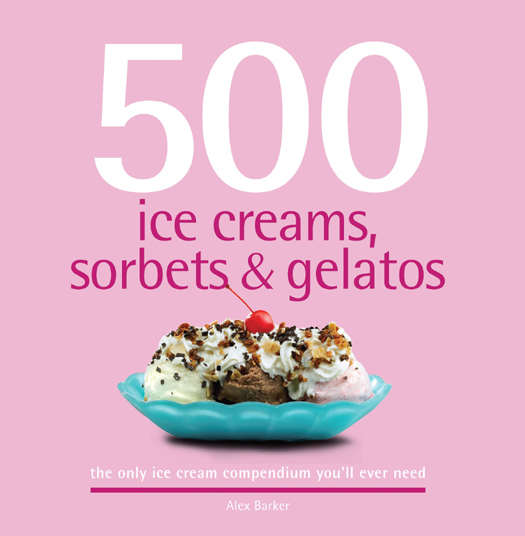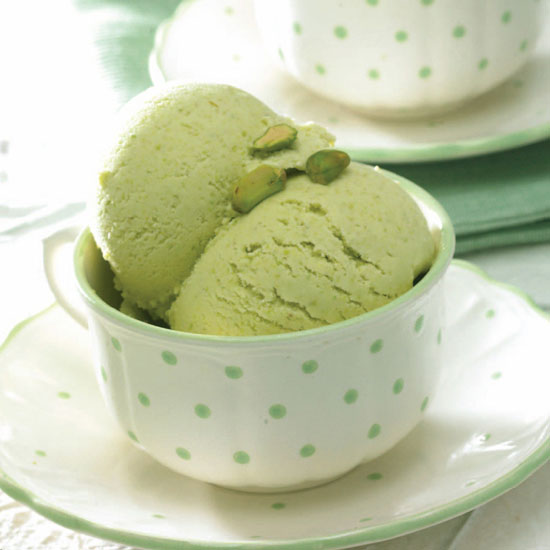
A Quintet Book
Published by Sellers Publishing Inc.161 John Roberts Road, South Portland, Maine 04106
Visit our Web site:
e-ISBN: 978-1-4162-0807-5
500 Ice Creams, Sorbets & Gelatos copyright 2013 Quintet Publishing Limited. All rights reserved under International and Pan-American copyright conventions. By payment of the required fees, you have been granted the nonexclusive, nontransferable right to access and read the text of this e-book onscreen. No part of this text may be reproduced, transmitted, downloaded, decompiled, reverse engineered, or stored or introduced into any information storage and retrieval system, in any form, by any means, whether electronic or mechanical, now known or hereinafter invented, without the express written permission of Sellers Publishing, Inc. e-books.
March 2013
This book was designed and produced by
Quintet Publishing Limited
6 Blundell Street
London N7 9BH
United Kingdom
Project Editor: Robert Davies
Designer: Dean Martin
Copy Editor: Cary Hull
Photography: Alex Barker, Dave Jordan
Food Styling: Sophie Northcote-Smith, Louise Halswell
Art Director: Michael Charles
Managing Editor: Donna Gregory
Publisher: James Tavendale
The author would like to thank the following manufacturers for the loan of ice cream machines to help with creating and testing recipes: Phillips, Kenwood, Cuisinart, and Magimix.
contents
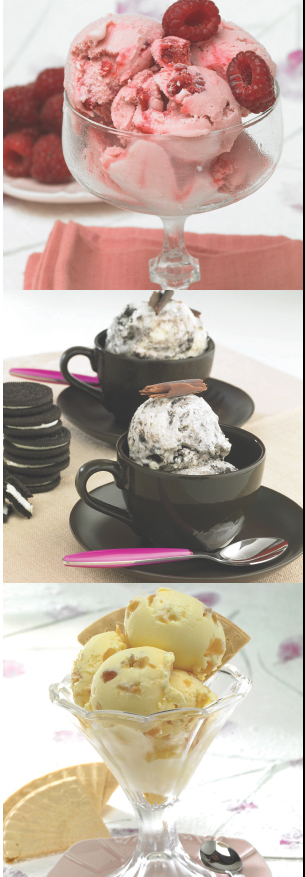
introduction
Over the years, books have related numerous tales of the origins of ice cream how the Roman Emperor Nero would send slaves to the mountains to collect snow to mix with fruit and honey; how Marco Polo discovered it on his travels in China in the thirteenth century; and how Charles I served a newly created sweet frozen dessert at a royal banquet in seventeenth-century England. Weve been told that George Washington and Thomas Jefferson served ice cream at presidential banquets, that the first ice cream parlor opened in New York in 1770, and that the waffle cone was created in the early twentieth century.
Ice cream has come a long way over the centuries. Its been Americanized with all sorts of added goodies (cookie dough, candies, peanut butter, and countless more). Its been made rich and velvety smooth and sophisticated by the French with their creamy egg custards. In Italy, its gelato a simpler version using mainly milk, plus eggs and cream. Middle Eastern sherbet or serbet (a drink of water sweetened with fruit or fruit pure and frozen) has become sorbet, which in America is generally enriched with milk. Ask for a sorbet in Italy, and you may get the softer-textured water ice, which can also go by the name granita. Granita the very granular or slushy frozen fruit ice is said to come from Sicily, where it is served almost as a drink.
But who cares about a name when youre licking the dribbles off a creamy ice cream cone, biting into a hot-cold baked Alaska, or diving into a sprinkle-and-whipped-cream-topped banana split? Chocoholics just want to be treated to the richest chocolate ice cream around. Hot Sunday afternoons call out for a delicate jasmine tea sorbet. The kick of lemon granita is just whats needed to cleanse the palate during a five-course dinner. And kids will love to try their hand at decorating ice cream cupcakes or blitzing frozen smoothies. Maybe ice creams bring back happy childhood memories, or perhaps youre just a sucker for their sweet cool creaminess or tongue-tingling fruity tang. Whatever the case, youre bound to find ideas in this book to tempt you again and again.
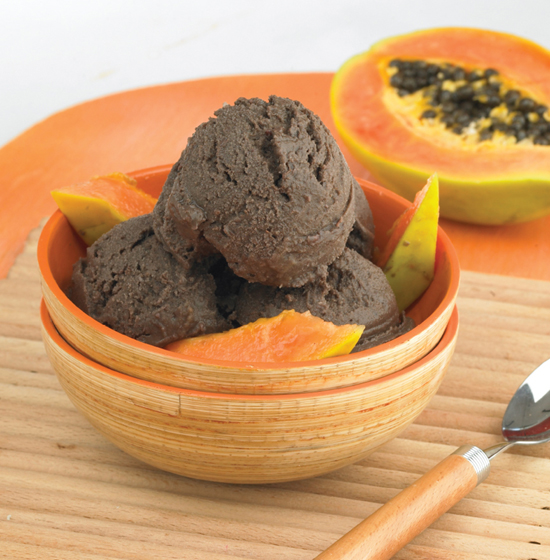
making ice cream
Making ice cream, at its simplest, is a matter of beating cream, eggs, sugar, and flavorings together and stirring this mixture frequently while it freezes. This is easily done by hand, though youll need to set aside about 4 or 5 hours to do so. An electric ice cream maker will save time and effort, and it does produce a softer, smoother, and creamier result.
ice cream makers
There are many ice cream machines available today to fit all price brackets. The simplest consist of a bucket container that needs to be frozen for at least 24 hours in advance, creating an aluminum ice bucket. This is fitted into a base with an electric paddle top and enclosed lid. When you turn on the machine and pour in the mixture, it churns inside the pre-iced bucket until sufficiently frozen. The fully automatic machines are large, heavy, and costly, because they have a built-in cooling system. You dont have to prefreeze the bucket and you can buy one with a timer, so you can switch it on and leave it. You still need to be ready at the end, however, to decant the frozen ice quickly into a container for the final minutes of freezing or for storage.
basic hand-mixing method
It is the blending and whisking that gives the smooth creamy finish we associate with a really good ice cream. If you use an ice cream maker, your ice cream will have 30 to 40 minutes of consistent stirring or churning. Making it by hand can produce as good a result but with some more effort.
The ingredients for hand-mixed ice cream should be well chilled before theyre combined. The mixture is then poured into a freezer container deep enough to allow space for later mixing. The container needs to be covered with a sheet of plastic wrap or waxed paper so it can freeze more evenly, and then topped with a well-fitting lid. Place the container in the coldest part of a really cold freezer. Leave for about 1 hour; then, using a fork, scrape the frozen ice cream in from the edges, and then whisk to a smooth, even texture. Cover the container again and return to the freezer for another hour. Repeat this process once or twice more at least, until the ice cream is smooth and nearly evenly frozen. Then cover and leave it to freeze completely.
marbling & rippling
Marbled or rippled ice creams look terrific and give the bonus of extra flavor. To make one, prepare the ice cream in a machine or by hand. Then, as you transfer it to a freezer container (or after the final stirring of a hand-mixed ice cream), spoon on the rippling or marbling ingredient or sauce and fold it in just a couple of times. Do not stir it through. The real marbling and rippling effect is acquired when you later scoop out the ice cream.
molding & shaping
When ice cream is sufficiently mixed and firm but not frozen hard, it can be put into a shaped container or mold, but work quickly because it will be softening all the time. Be sure to make the top completely flat and scrape away any excess from the edges so its easier to unmold. Cover with waxed paper and refreeze as soon as possible. It is also helpful to line any molds or pans with plastic wrap for easy removal.
piping
Ice cream can be piped if it is a perfectly smooth recipe, with no seeds or texture, and if it is well frozen but not solid. Place a small quantity in a piping bag with a fluted nozzle and pipe swirls quickly into a chilled dish, cupcake liners, or onto serving wafers and return to the freezer immediately. Only do a small quantity at a time, because your hands on the bag will speed up melting time.


